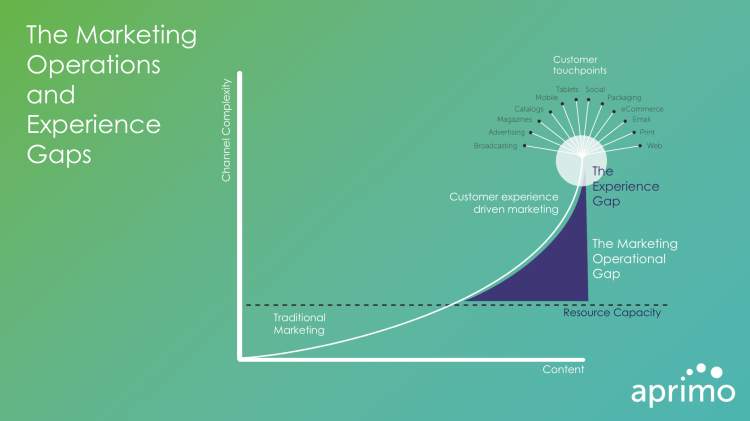Historically marketing focused on local and static connections through three major channels: print, TV, and radio. Brands dominated the conversation and customers were just recipients of this messaging. Those days are long gone. With the explosion of digital touchpoints, marketers today manage an average of 23 channels.[1] Customers are demanding a more personalized, relevant experience brought to them on each of their chosen channels and who knows what tomorrow will bring, with the emergence of new channels like IoT and chatbots.
Where change and stagnation meet: Despite all this change, most marketing organizations are still operating in the old world. They have the same processes, the same levels of resources, and the same agencies of the past. But these old ways of working just don?t move fast enough or scale to meet their personalized, omnichannel goals. Targeting more channels with greater speed strains marketing operations. This scenario gives life to some common scenarios:
- Ineffective processes. The last time you worked on a project, how much time did you spend finding the right assets? Could team members share and capture feedback easily? How easily were you able to get brand approval for a specific campaign? Traditional marketing processes are usually ad hoc and therefore aren?t scalable for growing digital needs. Creativity and velocity lose out to these day-to-day inefficiencies. One brand I spoke with told me they had to cross the street, go to another building, and leave a post-it note on someone?s desk to get content approval. Another brand told me it takes them over 40 days to get any new experience approved, even though their customers wanted experiences delivered immediately.
- Ineffective resource management. In your organization, does each person know the all of the tasks on their plate at any given time? Do marketing leaders easily have insight into who has capacity to work on more activities? Are workloads balanced among team members so no one burns out? Do you know which parts of the projects your teammates are managing? Outdated operations lead to imbalances of work, lack of visibility into your organization, and missed deadlines.
- Toxic work environment. One retailer told us that their current way of working is to be told Monday which campaigns to run; Wednesday being told that the campaign isn?t happening anymore; and then working late on Friday night to come up with a new campaign idea. This way of working?isn?t conducive to a strong and positive marketing culture and is a recipe for burnout. This is crucial because employees consider company culture a major component of their own professional success. According to a Glassdoor survey, 76% of job seekers want details on what makes a company an attractive place to work. Knowing basic information such as what to do, who to ask, and how individual projects fit together provides the day-to-day structure allowing you to share your most inspired ideas. Not knowing these plus keeping up with unrealistic deadlines leads to frustration at co-workers and personal stress.
You can?t keep up in the current scenario, we call this the Marketing Operations Gap. So many of marketers today are preoccupied with the next best way to execute and deliver experiences, that they aren?t efficiently running their marketing operations so they can do more with the resources and budget they have.

Close the Marketing Operations Gap with New Technologies
A 2017 study from Sirius Decisions found 40% of CMO?s expect to invest in marketing resource management and business intelligence technology in the next two years. Why? Because digital technology is fundamental to the transformation needed to deliver valuable experiences to customers. It is the only way to increase the speed and agility required to bridge the gap between limited resources and increasing expectations, and it?s essential to gain an advantage over the competition.
5 Critical Benefits of Marketing Operations Technologies
Marketing operations technologies provide the following benefits when closing the marketing operations gap:
- Single source of truth. Do you or the members of your team waste time digging through email threads or logging into multiple applications for the information you need? A single source of truth allows you to have the information you need at the click of a button. Whether you?re a CMO needing to report ROI, a designer looking for an approved image, or a project manager keeping things moving, you know where to go for accurate and current information. Bringing your content, data, people, and budgets together in one place not only saves time but ensures more efficiency and accurate marketing operations.
- Streamlined global processes. The number of people involved in a single campaign can be mind-boggling. When coordinating a creative campaign, it?s critical that everyone is on the same page from start to finish. Positive customer experiences require alignment across the entire organization. One central hub for content, data, people, and budgets allows marketers to share information seamlessly and eliminates time wasted when collaborating across multiple systems and creates a more streamlined global process.
- Marketing agility. Does launching a campaign feel like a disjointed, frenzied process? You know that meeting customer expectations requires an unprecedented amount of alignment and speed. Automating agile marketing will alleviate confusion on task ownership, prioritization, and give you clear visibility into tasks, projects, and schedules. Workflows today should be efficient, optimized, flexible, and intelligent. The ability to learn as you go and tailor workflows to the frameworks of past successes is critical to meeting the scale demanded by the consumer.
- Visibility and alignment. Have you ever burned the midnight oil to get a campaign out the door only to have it canceled at the last minute? Or worse, you get your campaign out, just to have it pulled back in due to misalignment with the business strategy? What about the digital creative that wasn?t aligned with the point of purchase materials, creating two different customer experiences? Marketing leaders need to close the gap to have better visibility into marketing groups? activities and to make connections between channels, regions, and business goals.
- Empowered marketing culture. When you?re frustrated you are not doing your best work ? even worse, cultural decline, people burn out, and turnover ensues. Once you shift the control back to marketing through the use of technology you are poised to reach peak productivity. You know what to work on, you have the time in your day to give it your best, and you know how the project fits into the overall strategy. Finding assets and asking questions is easy because you know where to go. Quality and agility replace frustration and bottlenecks – so you can deliver exceptional experiences.
For more information about how to enable your marketing department to achieve its full potential, look for our continuing blog series and watch our recently recorded webinar ? Mind the Gap: Making Marketing More Productive.
This is Part 2 in a four-part blog series. Be sure to check out the rest!
Additional blogs in the Mind the Gap Series:
- The 2 Biggest Marketing Gaps You Need to Know About
- Bringing Together the 4 Cornerstones of Marketing to Close the Gap
[1] Aprimo Customer Data, 2017
?





